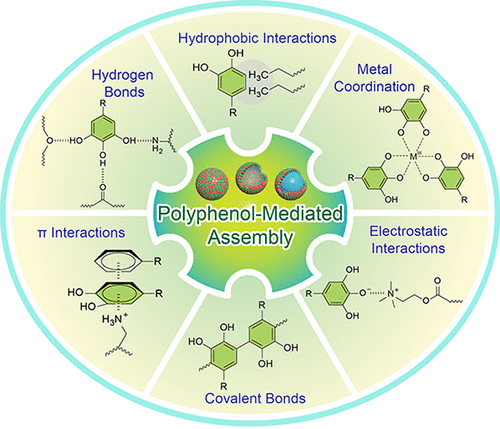当前位置:
X-MOL 学术
›
Acc. Chem. Res.
›
论文详情
Our official English website, www.x-mol.net, welcomes your
feedback! (Note: you will need to create a separate account there.)
Polyphenol-Mediated Assembly for Particle Engineering.
Accounts of Chemical Research ( IF 16.4 ) Pub Date : 2020-06-22 , DOI: 10.1021/acs.accounts.0c00150 Jiajing Zhou 1 , Zhixing Lin 1 , Yi Ju 1 , Md Arifur Rahim 1 , Joseph J Richardson 1 , Frank Caruso 1
Accounts of Chemical Research ( IF 16.4 ) Pub Date : 2020-06-22 , DOI: 10.1021/acs.accounts.0c00150 Jiajing Zhou 1 , Zhixing Lin 1 , Yi Ju 1 , Md Arifur Rahim 1 , Joseph J Richardson 1 , Frank Caruso 1
Affiliation

|
Polyphenols are naturally occurring compounds that are ubiquitous in plants and display a spectrum of physical, chemical, and biological properties. For example, they are antioxidants, have therapeutic properties, absorb UV radiation, and complex with metal ions. Additionally, polyphenols display high adherence, which has been exploited for assembling nanostructured materials. We previously reviewed the assembly of different phenolic materials and their applications (Angew. Chem. Int. Ed. 2019, 58, 1904–1927); however, there is a need for a summary of the fundamental interactions that govern the assembly, stability, and function of polyphenol-based materials. A detailed understanding of interactions between polyphenols and various other building blocks will facilitate the rational design and assembly of advanced polyphenol particles for specific applications. This Account discusses how different interactions and bonding (i.e., hydrogen, π, hydrophobic, metal coordination, covalent, and electrostatic) can be leveraged to assemble and stabilize polyphenol-based particles for diverse applications. In polyphenol-mediated assembly strategies, the polyphenols typically exert more than one type of stabilizing attractive force. However, one interaction often dominates the assembly process and dictates the physicochemical behavior of the particles, which in turn influences potential applications. This Account is thus divided into sections that each focus on a key interaction with relevant examples of applications to highlight structure–function relationships. For example, metal coordination generally becomes weaker at lower pH, which makes it possible to engineer metal–phenolic materials with a pH-responsive disassembly profile suitable for drug delivery. Engineered particles, such as hollow capsules, mesoporous and core–shell particles, and self-assembled nanoparticles are some of the systems that are covered to highlight how polyphenols interact with other building blocks and therefore make up the major focus of this Account. Some of the applications of these materials exemplified in this Account include drug delivery, catalysis, environmental remediation, and forensics. Finally, a perspective is provided on the current challenges and trends in polyphenol-mediated particle assembly, and viable near-term strategies for further elucidating the interplay of various competing interactions in particle formation are discussed. This Account is also expected to serve as a reference to guide fundamental research and facilitate the rational design of polyphenol-based materials for diverse emerging applications.
中文翻译:

多酚介导的粒子工程组件。
多酚是植物中普遍存在的天然化合物,并显示出一系列的物理,化学和生物学特性。例如,它们是抗氧化剂,具有治疗特性,吸收紫外线并与金属离子形成复合物。另外,多酚显示出高粘附性,已被用于组装纳米结构材料。我们以前审查不同的酚类物质及其应用(组装Angew。化学。诠释。埃德。2019,58,1904–1927);但是,需要对控制多酚基材料的组装,稳定性和功能的基本相互作用进行汇总。对多酚与其他各种结构单元之间相互作用的详细理解将有助于针对特定应用合理设计和组装高级多酚颗粒。该帐户讨论了如何利用不同的相互作用和键合(即氢,π,疏水,金属配位,共价和静电)来组装和稳定多酚基颗粒,以用于各种应用。在多酚介导的组装策略中,多酚通常发挥一种以上的稳定吸引力。然而,一种相互作用通常会主导组装过程,并决定颗粒的物理化学行为,进而影响潜在的应用。因此,该帐户分为多个部分,每个部分重点关注与应用程序相关示例的关键交互,以突出结构与功能的关系。例如,在较低的pH值下,金属的配位通常会变弱,这使得工程化金属-酚醛材料具有适用于药物输送的,具有pH响应的拆卸特性成为可能。工程粒子,例如空心胶囊,中孔和核壳粒子以及自组装的纳米粒子,是其中的一些系统,这些系统着重于突出多酚如何与其他结构单元相互作用,因此构成了该帐户的主要重点。在本帐户中举例说明的这些材料的某些应用包括药物输送,催化,环境修复和法医。最后,提供了有关多酚介导的颗粒组装中当前挑战和趋势的观点,并讨论了进一步阐明颗粒形成过程中各种竞争相互作用的相互作用的可行的近期策略。该帐户也有望用作指导基础研究和促进针对各种新兴应用的多酚基材料的合理设计的参考。讨论了进一步阐明粒子形成过程中各种竞争相互作用的相互作用的可行的近期策略。该帐户也有望作为指导基础研究和促进针对多种新兴应用的多酚基材料合理设计的参考。讨论了进一步阐明粒子形成过程中各种竞争相互作用的相互作用的可行的近期策略。该帐户也有望用作指导基础研究和促进针对各种新兴应用的多酚基材料的合理设计的参考。
更新日期:2020-07-21
中文翻译:

多酚介导的粒子工程组件。
多酚是植物中普遍存在的天然化合物,并显示出一系列的物理,化学和生物学特性。例如,它们是抗氧化剂,具有治疗特性,吸收紫外线并与金属离子形成复合物。另外,多酚显示出高粘附性,已被用于组装纳米结构材料。我们以前审查不同的酚类物质及其应用(组装Angew。化学。诠释。埃德。2019,58,1904–1927);但是,需要对控制多酚基材料的组装,稳定性和功能的基本相互作用进行汇总。对多酚与其他各种结构单元之间相互作用的详细理解将有助于针对特定应用合理设计和组装高级多酚颗粒。该帐户讨论了如何利用不同的相互作用和键合(即氢,π,疏水,金属配位,共价和静电)来组装和稳定多酚基颗粒,以用于各种应用。在多酚介导的组装策略中,多酚通常发挥一种以上的稳定吸引力。然而,一种相互作用通常会主导组装过程,并决定颗粒的物理化学行为,进而影响潜在的应用。因此,该帐户分为多个部分,每个部分重点关注与应用程序相关示例的关键交互,以突出结构与功能的关系。例如,在较低的pH值下,金属的配位通常会变弱,这使得工程化金属-酚醛材料具有适用于药物输送的,具有pH响应的拆卸特性成为可能。工程粒子,例如空心胶囊,中孔和核壳粒子以及自组装的纳米粒子,是其中的一些系统,这些系统着重于突出多酚如何与其他结构单元相互作用,因此构成了该帐户的主要重点。在本帐户中举例说明的这些材料的某些应用包括药物输送,催化,环境修复和法医。最后,提供了有关多酚介导的颗粒组装中当前挑战和趋势的观点,并讨论了进一步阐明颗粒形成过程中各种竞争相互作用的相互作用的可行的近期策略。该帐户也有望用作指导基础研究和促进针对各种新兴应用的多酚基材料的合理设计的参考。讨论了进一步阐明粒子形成过程中各种竞争相互作用的相互作用的可行的近期策略。该帐户也有望作为指导基础研究和促进针对多种新兴应用的多酚基材料合理设计的参考。讨论了进一步阐明粒子形成过程中各种竞争相互作用的相互作用的可行的近期策略。该帐户也有望用作指导基础研究和促进针对各种新兴应用的多酚基材料的合理设计的参考。











































 京公网安备 11010802027423号
京公网安备 11010802027423号